|
Advantech ARK-2150L High-Performance Embedded Box PC
Compact rugged, versatile fanless embedded industrial Box PC with plenty of connectivity, expansion, and Intel 3rd gen Core processing power
(by Conrad H. Blickenstorfer; photography by Carol Cotton)
Users of rugged and special-purpose computing machinery appreciate the inherent durability, longevity and reliability of such devices, but not so much the general lack of current state-of-the-art technology available in those often low-volume products. There are reasons for lagging behind, among them the longer product cycles, the cost associated with tech updates, the need for legacy support and compatibility, and so on. While those are all valid concerns, it means that customers often miss out on the incredible advances in microprocessor technology where the latest technology provides more performance and new features at lower cost and lower power consumption. Is there a solution to this predicament?
There is. Embedded systems manufacturers have long since realized that splitting systems into a processing component and a solutions board component is the way to go. This way, when new technology comes along, you simply plug a new CPU module into the solutions board. It's a way of doing business that embedded systems providers such as Advantech have been practicing for years and decades. And while Industrial Box PCs such as the ARK-2150L reviewed in this article are actually complete PCs, they benefit from an embedded systems corporate culture of always quickly providing the latest technology to their customers. That's the long way of introducing the 2150 that uses Intel's 3rd generation Core processor technology. Yes, the 4th generation ("Haswell") has already been introduced, but in an industry that often lags several processor generations behind, that is remarkable.
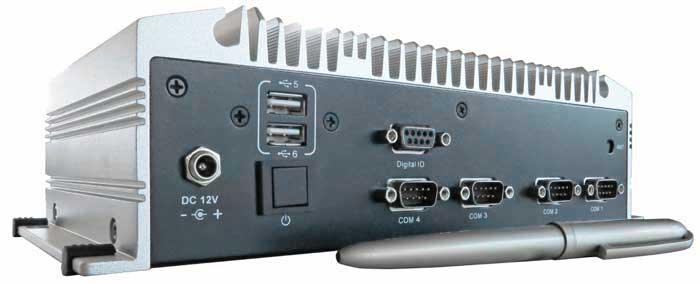
Advantech introduced the ARK-2150 in May 2013 as a compact, high-performance fanless Box PC that combines 3rd generation Intel Core processor computing power and efficiency with Advantech's SUSIAccess remote device management and iManager self-monitoring and management software services. Measuring 10.4 x 5.25 inches, the ARK-2150 has a footprint smaller than that of a 10-inch Samsung Galaxy tablet. It's about three inches tall and weighs around five pounds. That is quite compact for an industrial-grade, industrial-strength PC with advanced computing power and massive onboard connectivity.
As is the case with most Box PCs, the ARK-2150 is available with various operating systems. Those include Windows 8, Windows 7, Windows XP, as well as their embedded versions. Ubuntu Linux and QNX are also supported, and the spec sheet even lists Windows CE 7.0. On the CPU side, there's a choice between the Intel Core i3-3217UE and the Core i7-3517UE, both ultra-low voltage embedded versions, and both working with the Intel QM77 chipset. The ARK-2150, of course, has full-size, industry-standard ports and jacks, and not the fragile mini and micro versions of them.
What are the intended uses for the ARK-2150? There is no single answer. This is a multi-purpose device with enough computing power for advanced tasks, enough connectivity to connect to almost everything, and even the ability to drive two or even three independent displays. And the compact, fanless design means the unit can be deployed almost anywhere, even in places where there is no easy access for repairs and maintenance. Storage and expansion aren't an issue either, as the ARK-2150 can accommodate large capacity mass storage devices, as well as mSATA, WLAN and 3G/4G modules via the three internal PCIe slots.
Like almost all current industrial PCs, the Advantech ARK-2150L consists of a steel chassis on which are mounted the various electronic components, and a massive U-shaped finned aluminum heatsink that gives the device its characteristic appearance. The ARK-2150L, like all of Advantech's ARK industrial PCs, is a fanless design. Even though the unit uses those powerful Intel 3rd gen Core processors, there is no need for a fan or even thermal heat pipes; it is the massive finned external aluminum housing/heatsink that handles the removal of heat. Though the two available processors are ultra-low voltage designs, their thermal design power is still 17 watts, but the ARK-2150L actually heated up far less than the Intel Atom N2800-based ARK-1122 that we tested immediately prior to the ARK-2150L. It never got more than luke-warm.
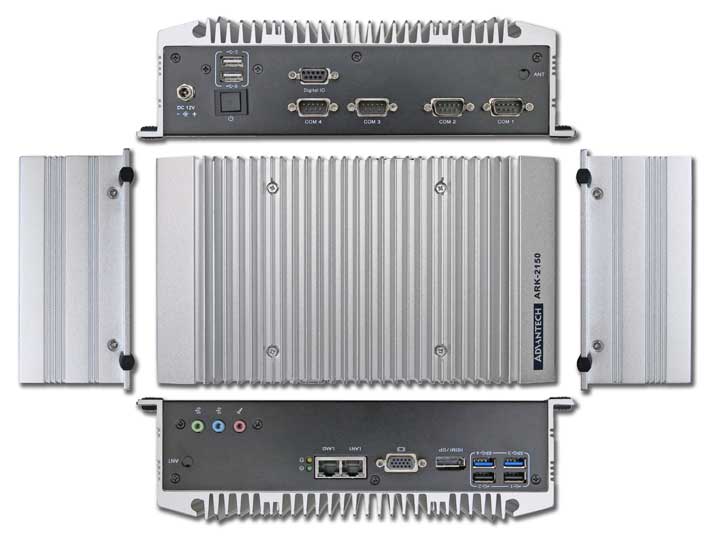
In terms of functionality and connectivity, the Advantech ARK-2150L Box PC doesn't only pack a hefty processing punch, it's also well equipped to interface with a wide variety of peripherals in both legacy (RS232/422/485) serial protocols as well as the latest high-speed USB 3.0 standard. Our review ARK-2150L was configured to offer the following external ports:
- 2 x USB 3.0
- 4 x USB 2.0
- 2 x Serial RS232
- 2 x Serial RS232/422/485 with auto flow control
- 2 x RJ-45 gigabit LAN
- 2 x Antenna (optional)
- 1 x Digital I/O
- Power (9 Volt DC)
- 1 x 15-pin VGA video
- 1 x HDMI/DisplayPort
- Audio microphone-in, line-in and line-out
The ARK-2150L is designed to run off either mSATA solid state storage via an internal mini PCIe slot, or a SATA 2.5-inch hard drive or solid state disk. Our review unit ran Windows Embedded Standard 7 on a 32GB Advantech industrial grade SATA II 32GB SQF-S25M8-32G-S5E SQFlash module. The picture below shows off the compact size of this powerful Advantech Box PC, with a standard ball point pen added in the foreground for comparison.
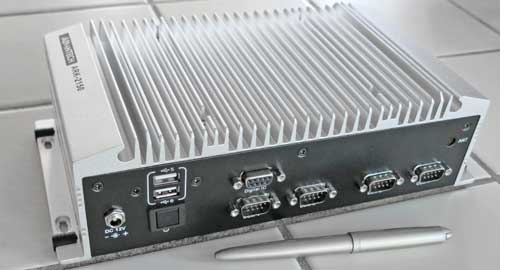 Like all of Advantech's industrial PCs, the interior of the ARK-2150L is exceptionally organized and clean. The motherboard measures roughly 5.5 x 4 inches and is complemented by an irregular-shaped I/O daughterboard. Like in most PCs, part of the external connectivity is via edge-mount connectors, and part via cable-connected jacks and ports. This separates core-connectivity from configurable I/O. Since devices such as this industrial PC are often subjected to shock and vibration, all cable connections to the circuit boards are secured via dollops of glue. Like all of Advantech's industrial PCs, the interior of the ARK-2150L is exceptionally organized and clean. The motherboard measures roughly 5.5 x 4 inches and is complemented by an irregular-shaped I/O daughterboard. Like in most PCs, part of the external connectivity is via edge-mount connectors, and part via cable-connected jacks and ports. This separates core-connectivity from configurable I/O. Since devices such as this industrial PC are often subjected to shock and vibration, all cable connections to the circuit boards are secured via dollops of glue.
The unit's three PCI-e slots are fully accessible upon removal of the bottom plate, making configuration and service easy. The I/O board also contains an easily accessible SIM Card tray.
From a ruggedness standpoint, the enemy of embedded devices such as the ARK-2150L are usually temperatures extremes and shock/vibration. Since they are not carried around, the drop spec and IP rating (sealing against solids and liquids) that in part define the durability of mobile devices are essentially irrelevant. As a result, there's no IP number and no drop spec, but a wide operating temperature range (-4 to 140 degrees Fahrenheit), as well as detailed shock and vibration test numbers.
To provide an idea of the relative performance of the ARK-2150L, we ran our two standard benchmark suites, PassMark and CrystalMark. For comparison, we're also listing the results of a couple of older Intel Core-based Advantech IPCs we have reviewed and benchmarked, as well as a recent example of an Intel Core-based Advantech industrial microATX motherboard, the AIMB-501.
|
Advantech Intel Core-based ARK Box PC Benchmarks and Comparisons
|
|
PERFORMANCE COMPARISON
|
Advantech
|
Advantech
|
Advantech
|
Advantech
|
|
Model
|
ARK-2150L
|
ARK-3390
|
ARK-3440
|
AIMB-501
|
|
Model (click pic for review)
|

|

|

|

|
|
Year tested
|
2013
|
2009
|
2011
|
2013
|
|
Intel Core processor
|
i7-3517UE
|
Duo L2400
|
i7-610
|
i5-3550S
|
|
CPU Speed
|
1.7/2.8GHz
|
1.66GHz
|
2.53GHz
|
3.3/3.7GHz
|
|
OS Software
|
WES7
|
XPE
|
XPE
|
WES7
|
|
Thermal Design Power (TDP)
|
17 watts
|
15 watts
|
35 watts
|
77 watts
|
|
CPU Mark
|
3,164.8
|
847.9
|
NA
|
4,734.2
|
|
2D Graphics Mark
|
475.8
|
149.3
|
NA
|
473.5
|
|
Memory Mark
|
923.3
|
267.6
|
NA
|
965.1
|
|
Disk Mark
|
1,322.0
|
32.7
|
NA
|
1,161.7
|
|
3D Graphics Mark
|
253.1
|
22.5
|
NA
|
263.8
|
|
Overall PassMark
|
1,382.1
|
307.2
|
NA
|
1,782.2
|
|
CM ALU
|
41,554
|
12,662
|
35,793
|
75,391
|
|
CM FPU
|
39,544
|
15,443
|
40,328
|
63,139
|
|
CM MEM
|
23,799
|
6,305
|
18,458
|
32,993
|
|
CM HDD
|
34,772
|
3,832
|
4,932
|
32,448
|
|
CM GDI
|
11,924
|
1,225
|
927
|
14,392
|
|
CM D2D
|
1,991
|
1,566
|
3,009
|
2,667
|
|
CM OGL
|
6,318
|
469
|
819
|
7,721
|
|
Overall CrystalMark
|
159,902
|
41,502
|
104,266
|
228,751
|
Note that even within closely related processor brands and families, benchmark results often yield confusing numbers (especially in graphics) and it often feels like comparing apples and oranges. In our experience of benchmarking many hundreds of rugged mobile and industrial computing devices, however, we've found that the overall bottomline numbers generally provide a good measure of actual perceived performance.
With the above in mind, it's quite obvious how Intel Core processor performance has been steadily increasing over the years and through successive generations. Many of today's Intel Atom-based systems surpass the performance of low power Intel Core Duo and Core 2 Duo systems of just a few years ago (the recently tested Atom N2800-based Advantech ARM-1122 scored higher than the 2009 ARK3390 with its Core Duo), and each new generation of Intel Core processors offers more performance even as power consumption (and thus heat) goes down. And while standard voltage, fan-cooled systems such as Advantech's AIMB-501 ATX board outperform fanless systems, the performance difference is actually smaller than one might expect, especially given the great difference in TDP.
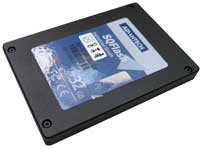 One other thing we've found to be of great importance to the performance of these kinds of system, and I want to emphasize this here as well, is the type of storage used. Often, selecting the right type of solid state storage can make significantly more of a difference to overall performance than the processor. Finally, for additional benchmark data, check this page of UK-based Advantech reseller ECA Services. One other thing we've found to be of great importance to the performance of these kinds of system, and I want to emphasize this here as well, is the type of storage used. Often, selecting the right type of solid state storage can make significantly more of a difference to overall performance than the processor. Finally, for additional benchmark data, check this page of UK-based Advantech reseller ECA Services.
As far as choosing between the available i3 and i7 processor, it's a cost issue, a performance issue, and also an issue which of Intel's advanced integrated technologies are needed for a given project. Though the base clock speed of the i3 and i7 processors isn't very different, and both have a maximum TDP of 17 watts, the i7 chip can run as fast as 3GHz in Turbo mode whereas the i3 does not have a turbo mode. For a side-by-side comparison of the two processors see here.
Before deciding, do further note that Advantech offers two versions of the ARK-2150, the 2150L reviewed here, and also the 2150F. Among the noticeable differences between the two, the 2150F adds a DVI-D video port for triple independent displays, wide 12-24V DC support, quad RJ45 LAN ports, an extra USB 3.0 port, and an external SIM slot (see the ARK-2150F product page here).
Like many Advantech embedded products, the ARK-2150 includes SUSIAccess software, a remote management API that can be used to monitor, configure, and control terminals in a centralized, real-time maintenance system. Our review system also included Advantech's Booting Manager, EWF (Enhanced Write Filter) Manager, and a FBWF (File Based Write Manager) utility.
As is, the Advantech ARK-2150L provides an attractive balance between very respectable performance, compact size, and comprehensive onboard connectivity, making it a suitable platform for any number of extreme environment applications such as police surveillance, medical imaging, semiconductor machinery/AOI, and high level machine automation.
-- Conrad H. Blickenstorfer
Advantech ARK-2150L High Performance Embedded Box PC Specs:
| Status |
Added 06/2013
|
| Type |
High Performance Embedded Box IPC
|
| CPU Type |
1.6GHz Intel Core i3-3217UE or
1.7GHz (max. Turbo 2.8GHz) Intel Core i7-3517UE
|
| Chipset |
Intel QM77
|
| BIOS |
AMI EFI 64Mbit
|
| OS |
Windows Embedded Standard 7, Windows 7 Professional, Windows XP Embedded, XP Professional, Windows CE 7.0
|
| Memory |
Max 8GB DDR3L 1333MHz in 1 204-pin SODIMM socket |
| Graphics Controller |
Integrated Intel HD Graphics 4000 |
| Watchdog Timer |
255-level timer intervals, software setup |
| Graphics: VGA |
Integrated 340.4MHz RAMDAC, max. resolution 2048 x 1536 pixel |
| Graphics: HDMI |
HDMI 1.4; supports 2560 x 1600 on DisplayPort, 1920 x 1200 on HDMI |
| Graphics: Dual Display |
Yes, either VGA + HDMI or VGA + DisplayPort/td>
|
| LAN |
2 x 10/100/1000 Mbps (Intel 82579LM and 82583V) LAN RJ45 |
| Storage |
1 x SATA 2.5" HDD, 1 x internal mSATA socket
|
| Housing |
Aluminum with optional DIN-rail, VESA and/or wall mounts
|
| Vibration |
With SSD: 5 Grms, IEC 60068-2-64, random, 5 ~ 500 Hz, 1hr/axis.
|
| Shock |
With SSD: 50 Grms, IEC 60068-2-27, half sine, 11 ms duration.
|
| EMC |
CE/FCC Class A, CCC, BSMI
|
| Safety |
CB, UL, CCC, BSMI
|
| Operating temperature |
With extended temp. peripherals: -4° to 140°F (-20° to °60C)
|
| USB |
2 x USB 3.0, 4 x USB 2.0
|
| Serial |
2 x RS232 serial, 2 x RS232/422/485 |
| Audio |
HD Audio Realtek ALC892 chipset, line-in + line-out jacks |
| Expansion |
1 x full-size Mini PCIe, 1 x half-size Mini PCIe |
| DIO |
8-bit programmable GPIO |
| Size |
10.4 x 5.25 x 3.0 inches (265 x 133 x 75 mm)
|
| Weight |
5.1 pounds (2.3 kg) |
| Power |
12VDC via adapter
|
| Price |
Inquire |
| Webpage |
Advantech ARK-2150L page and product announcement
|
| Datasheet |
 ARK-2150L ARK-2150L |
Advantech Corporation
13 Whatney
Irvine, CA 92618
Toll Free: 1-800-866-6008
Ph: 949-420-2500
Fax: 949-420-2501
ECGInfo@advantech.com
www.advantech.com
Advantech Co. Ltd.
No.1, Alley 20, Lane 26, Rueiguang Road
Neihu District, Taipei Taiwan 114, R.O.C.
Tel: 886-2-2792-7818
Fax: 886-2-2794-7301
www.advantech.com
|



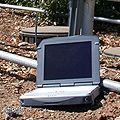


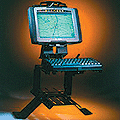







 Like all of Advantech's industrial PCs, the interior of the ARK-2150L is exceptionally organized and clean. The motherboard measures roughly 5.5 x 4 inches and is complemented by an irregular-shaped I/O daughterboard. Like in most PCs, part of the external connectivity is via edge-mount connectors, and part via cable-connected jacks and ports. This separates core-connectivity from configurable I/O. Since devices such as this industrial PC are often subjected to shock and vibration, all cable connections to the circuit boards are secured via dollops of glue.
Like all of Advantech's industrial PCs, the interior of the ARK-2150L is exceptionally organized and clean. The motherboard measures roughly 5.5 x 4 inches and is complemented by an irregular-shaped I/O daughterboard. Like in most PCs, part of the external connectivity is via edge-mount connectors, and part via cable-connected jacks and ports. This separates core-connectivity from configurable I/O. Since devices such as this industrial PC are often subjected to shock and vibration, all cable connections to the circuit boards are secured via dollops of glue.




 One other thing we've found to be of great importance to the performance of these kinds of system, and I want to emphasize this here as well, is the type of storage used. Often, selecting the right type of solid state storage can make significantly more of a difference to overall performance than the processor. Finally, for additional benchmark data,
One other thing we've found to be of great importance to the performance of these kinds of system, and I want to emphasize this here as well, is the type of storage used. Often, selecting the right type of solid state storage can make significantly more of a difference to overall performance than the processor. Finally, for additional benchmark data, 